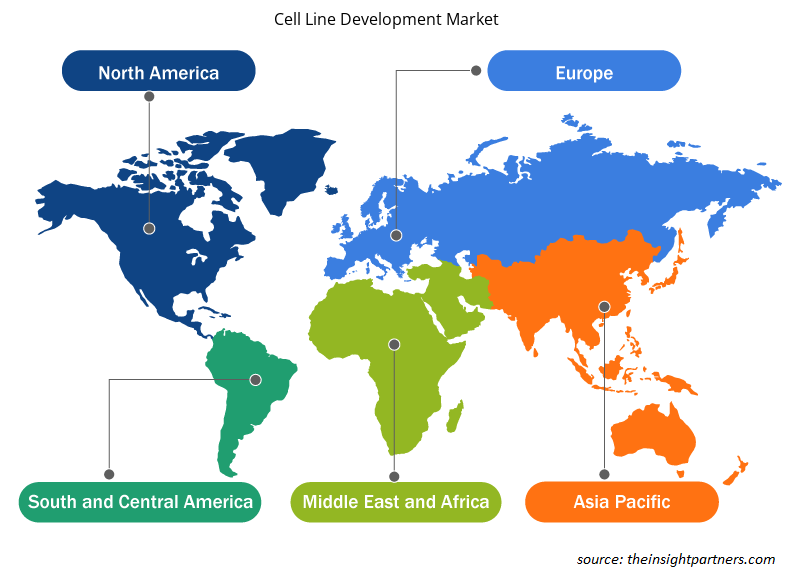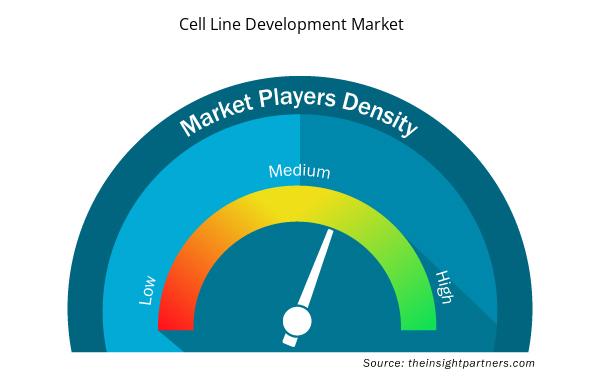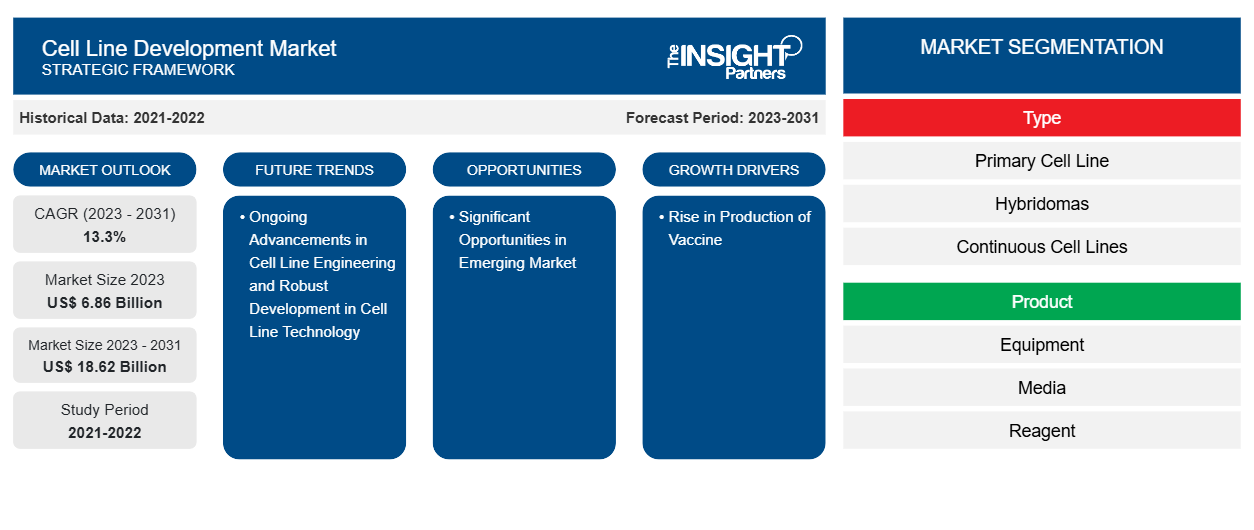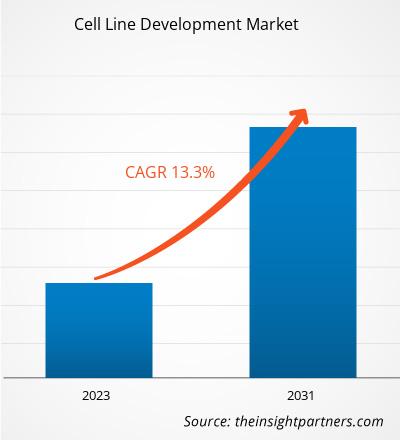Le marché du développement des lignées cellulaires était évalué à 6,86 milliards USD en 2023 et devrait atteindre 18,62 milliards USD d'ici 2031. Le marché devrait enregistrer un TCAC de 13,3 % en 2023-2031. Les progrès continus dans l'ingénierie des lignées cellulaires et le développement robuste de la technologie des lignées cellulaires resteront probablement les principales tendances du marché du développement des lignées cellulaires.
Analyse du marché du développement de lignées cellulaires
Le développement de lignées cellulaires est essentiel pour évaluer la toxicité, les tests in vitro et l'efficacité de la découverte de nouveaux médicaments. Cette procédure réduit le risque d' échec des médicaments pendant les essais cliniques en économisant de l'argent, du temps et des efforts. Des protéines recombinantes sont générées tout au long de la procédure de développement de lignées cellulaires. Il s'agit notamment de vaccins, de protéines de fusion, de facteurs de croissance, d'enzymes, d'anticorps bispécifiques et monoclonaux et de nouvelles approches pour créer des immunothérapies pour le traitement du cancer. Les chercheurs cherchent des moyens de franchir les premières étapes de la découverte biothérapeutique et de la sélection des candidats afin de réduire les coûts associés au développement de lignées cellulaires. Ce processus est efficace car il produit et sélectionne rapidement des lignées cellulaires qui produisent des protéines recombinantes de haute qualité en grande quantité et élimine les candidats clones susceptibles d'échouer dès que possible. Les progrès technologiques dans le développement de lignées cellulaires ont accéléré les tests de différents candidats médicaments dans les premières phases de développement, ce qui a permis d'économiser du temps et de l'argent.
En outre, les entreprises engagées dans la découverte de médicaments et le développement de lignées cellulaires coopèrent, élargissant ainsi le secteur. Par exemple, Cytiva a récemment acheté CEVEC Pharmaceuticals, un important fournisseur allemand de technologies pour la production de vecteurs viraux et de lignées cellulaires à haute performance. Bio-Techne Corporation a déclaré en juillet 2022 que Namocell, Inc. avait été entièrement acquise. Des plateformes simples de tri et de distribution de cellules individuelles qui protègent la viabilité et l'intégrité des cellules sont mises à disposition par l'acquisition de Namocell. Dans de nombreux flux de travail en biothérapie et en diagnostic, tels que le développement et la commercialisation de thérapies cellulaires et géniques, l'ingénierie cellulaire, le développement de lignées cellulaires, la génomique unicellulaire, la découverte d'anticorps, la biologie synthétique et l'isolement de cellules rares, les outils et consommables de Namocell sont des technologies essentielles.
Aperçu du marché du développement de lignées cellulaires
Le processus de sélection des machines cellulaires pour produire des produits biologiques thérapeutiques ou d'autres protéines intéressantes est appelé développement de lignées cellulaires. Les levures, les mammifères, les plantes et les bactéries peuvent utiliser plusieurs systèmes d'expression pour développer des lignées cellulaires. Les cellules ovariennes de hamster chinois (CHO) cultivées en suspension sont le plus souvent utilisées pour produire la protéine complexe. Ces cellules sont ensuite utilisées dans des bioréacteurs au cours de l'étape de fabrication. Les cultures en suspension à petite échelle constituent la première étape du développement de lignées cellulaires, qui passent ensuite aux bioréacteurs à grande échelle au cours de la fabrication. L'application de lignées cellulaires pour générer des produits thérapeutiques transforme tous les aspects de l'industrie biopharmaceutique, de la création de thérapies géniques innovantes à la production de vaccins de pointe et de médicaments contre le cancer. Cela crée à son tour des opportunités importantes sur le marché.
Personnalisez ce rapport en fonction de vos besoins
Vous bénéficierez d'une personnalisation gratuite de n'importe quel rapport, y compris de certaines parties de ce rapport, d'une analyse au niveau des pays, d'un pack de données Excel, ainsi que de superbes offres et réductions pour les start-ups et les universités.
- Obtenez les principales tendances clés du marché de ce rapport.Cet échantillon GRATUIT comprendra une analyse de données, allant des tendances du marché aux estimations et prévisions.
Moteurs et opportunités du marché du développement des lignées cellulaires
L'augmentation de la production de vaccins devrait favoriser le marché
De nombreuses méthodes de production de grandes quantités de protéines antigéniques ont dû être développées en réponse à la demande croissante de produits vaccinaux. Les développeurs de vaccins adhèrent généralement à un processus linéaire qui comprend une analyse et une vérification approfondies des données pour se prémunir contre des taux d'échec historiquement élevés. Les principaux producteurs de vaccins et de médicaments antiviraux déploient de nombreux efforts pour créer de nouvelles approches de production de vaccins candidats contre la pandémie et la grippe saisonnière. Jusqu'à récemment, la plupart des efforts ont été consacrés au développement de vaccins homologués à base d'œufs. Pour répondre aux demandes de la prochaine campagne saisonnière et pour produire des prototypes de vaccins pandémiques pour les essais cliniques, les fabricants se sont concentrés sur l'augmentation des capacités de production et l'automatisation de certaines étapes en grande partie manuelles de la technologie des vaccins à base d'œufs. Ainsi, une augmentation de la production de vaccins est susceptible de stimuler la croissance du marché du développement de lignées cellulaires.
Des opportunités importantes sur les marchés émergents – Une opportunité sur le marché du développement des lignées cellulaires
Cell lines are needed for production because biologics and biosimilars are receiving more attention. Research and development opportunities in this field can be made possible through partnerships with government initiatives, biotech companies, and academic institutions. Furthermore, India is desirable for cell line development activities due to its highly skilled workforce and cheaper development costs than Western nations. For instance, through national funding organizations like the Department of Biotechnology (DBT), the Indian Council of Medical Research (ICMR), and the Department of Science and Technology (DST), the government supports the development of cell lines in developing nations like India.
Cell Line Development Market Report Segmentation Analysis
Key segments contributing to the cell line development market analysis derivation are type, product, and application.
- Based on type, the cell line development market is segmented into primary cell line, hybridomas, continuous cell lines, recombinant cell line. The recombinant cell line segment held a larger market share in 2023.
- By product, the market is segmented into equipment, media, reagent. The media & reagent segment held the largest share of the market in 2023.
- By application, the market is segmented into drug discovery, bioproduction, tissue engineering. The bioproduction segment held the largest share of the market in 2023.
Cell Line Development Market Share Analysis by Geography
The cell line development market report's geographic scope is divided into five regions: North America, Asia Pacific, Europe, Middle East & Africa, and South America/South & Central America.
North America has dominated the cell line development market. In North America, the US is the largest market for cell line development in 2023. The expansion of the US cell line development market is attributed to the different players in the industry, and the dynamic conditions established in this area have changed the dynamics of cell line development in the area. Key players in the market, a lot of research and development being done by different academic and research institutes, and a growing demand for novel products from biopharmaceutical and biotechnology companies are growth characteristics in North America. Furthermore, significant funding for genomic research from public and private entities, along with growing emphasis on the integration of advanced methods in healthcare and government and private initiatives to promote precision medicine, are anticipated to propel growth and generate exceptional revenue for the North American cell line development market. Due to numerous development initiatives and business plans that support the creation, discovery, or modification of diverse biomolecules and organisms through bioengineering techniques, medical biotechnology has experienced revolutions. The nation's new businesses with exciting and creative ideas have benefited from the Biotech Startup Revolution, which has also helped maximize revenue generation and North America's economic standing in the international cell line development market.
Cell Line Development Market Regional Insights
The regional trends and factors influencing the Cell Line Development Market throughout the forecast period have been thoroughly explained by the analysts at Insight Partners. This section also discusses Cell Line Development Market segments and geography across North America, Europe, Asia Pacific, Middle East and Africa, and South and Central America.

- Get the Regional Specific Data for Cell Line Development Market
Cell Line Development Market Report Scope
| Report Attribute | Details |
|---|---|
| Market size in 2023 | US$ 6.86 Billion |
| Market Size by 2031 | US$ 18.62 Billion |
| Global CAGR (2023 - 2031) | 13.3% |
| Historical Data | 2021-2022 |
| Forecast period | 2023-2031 |
| Segments Covered | By Type
|
| Regions and Countries Covered | North America
|
| Market leaders and key company profiles |
|
Market Players Density: Understanding Its Impact on Business Dynamics
The Cell Line Development Market market is growing rapidly, driven by increasing end-user demand due to factors such as evolving consumer preferences, technological advancements, and greater awareness of the product's benefits. As demand rises, businesses are expanding their offerings, innovating to meet consumer needs, and capitalizing on emerging trends, which further fuels market growth.
Market players density refers to the distribution of firms or companies operating within a particular market or industry. It indicates how many competitors (market players) are present in a given market space relative to its size or total market value.
Major Companies operating in the Cell Line Development Market are:
- Thermo Fisher Scientific Inc
- Merck KGaA
- Selexis SA (JSR Corporation)
- BioFactura, Inc
- Corning Incorporated
- Sartorius AG
Disclaimer: The companies listed above are not ranked in any particular order.

- Get the Cell Line Development Market top key players overview
Cell Line Development Market News and Recent Developments
The cell line development market is evaluated by gathering qualitative and quantitative data post primary and secondary research, which includes important corporate publications, association data, and databases. The following is a list of developments in the market for cell line development and strategies:
- Abzena announced on Jan. 16, 2023 the launch of AbZelect and AbZelectPRO, its new cell line development (CLD) platforms, designed to speed up the generation of production cell lines for the manufacture of antibodies and recombinant proteins. The platforms are intended to enable the rapid progress of complex biologic drug programs towards clinical trials and investigational new drug (IND) application filing. (Source: Abzena Company Name, Newletter, 2023)
- Lonza announced the launch of its new GS Effex cell line for the development of therapeutic antibodies with enhanced potency. The GS Effex cell line was developed to meet pressing market needs originating from the shift towards more sophisticated therapeutic antibodies. Derived from Lonza’s leading GS Xceed cell line, GS Effex fits effectively into Lonza platforms. Combined with good cell growth and the ability to produce therapeutic antibodies with increased potency, the new cell line provides a solution for therapeutic development from discovery stage research through to commercial manufacturing. (Source: Lonza Company Name, Press Release, 2023)
Cell Line Development Market Report Coverage and Deliverables
The “Cell Line Development Market Size and Forecast (2021–2031)” report provides a detailed analysis of the market covering below areas:
- Market size and forecast at global, regional, and country levels for all the key market segments covered under the scope
- Market dynamics such as drivers, restraints, and key opportunities
- Key future trends
- Detailed PEST/Porter’s Five Forces and SWOT analysis
- Analyse du marché mondial et régional couvrant les principales tendances du marché, les principaux acteurs, les réglementations et les développements récents du marché
- Analyse du paysage industriel et de la concurrence couvrant la concentration du marché, l'analyse de la carte thermique, les principaux acteurs et les développements récents
- Profils d'entreprise détaillés
- Analyse historique (2 ans), année de base, prévision (7 ans) avec TCAC
- Analyse PEST et SWO
- Taille du marché Valeur / Volume - Mondial, Régional, Pays
- Industrie et paysage concurrentiel
- Ensemble de données Excel



Report Coverage
Revenue forecast, Company Analysis, Industry landscape, Growth factors, and Trends

Segment Covered
This text is related
to segments covered.

Regional Scope
North America, Europe, Asia Pacific, Middle East & Africa, South & Central America

Country Scope
This text is related
to country scope.
Trends and growth analysis reports related to Life Sciences : READ MORE..
The Insight Partners performs research in 4 major stages: Data Collection & Secondary Research, Primary Research, Data Analysis and Data Triangulation & Final Review.
- Data Collection and Secondary Research:
As a market research and consulting firm operating from a decade, we have published and advised several client across the globe. First step for any study will start with an assessment of currently available data and insights from existing reports. Further, historical and current market information is collected from Investor Presentations, Annual Reports, SEC Filings, etc., and other information related to company’s performance and market positioning are gathered from Paid Databases (Factiva, Hoovers, and Reuters) and various other publications available in public domain.
Several associations trade associates, technical forums, institutes, societies and organization are accessed to gain technical as well as market related insights through their publications such as research papers, blogs and press releases related to the studies are referred to get cues about the market. Further, white papers, journals, magazines, and other news articles published in last 3 years are scrutinized and analyzed to understand the current market trends.
- Primary Research:
The primarily interview analysis comprise of data obtained from industry participants interview and answers to survey questions gathered by in-house primary team.
For primary research, interviews are conducted with industry experts/CEOs/Marketing Managers/VPs/Subject Matter Experts from both demand and supply side to get a 360-degree view of the market. The primary team conducts several interviews based on the complexity of the markets to understand the various market trends and dynamics which makes research more credible and precise.
A typical research interview fulfils the following functions:
- Provides first-hand information on the market size, market trends, growth trends, competitive landscape, and outlook
- Validates and strengthens in-house secondary research findings
- Develops the analysis team’s expertise and market understanding
Primary research involves email interactions and telephone interviews for each market, category, segment, and sub-segment across geographies. The participants who typically take part in such a process include, but are not limited to:
- Industry participants: VPs, business development managers, market intelligence managers and national sales managers
- Outside experts: Valuation experts, research analysts and key opinion leaders specializing in the electronics and semiconductor industry.
Below is the breakup of our primary respondents by company, designation, and region:

Once we receive the confirmation from primary research sources or primary respondents, we finalize the base year market estimation and forecast the data as per the macroeconomic and microeconomic factors assessed during data collection.
- Data Analysis:
Once data is validated through both secondary as well as primary respondents, we finalize the market estimations by hypothesis formulation and factor analysis at regional and country level.
- Macro-Economic Factor Analysis:
We analyse macroeconomic indicators such the gross domestic product (GDP), increase in the demand for goods and services across industries, technological advancement, regional economic growth, governmental policies, the influence of COVID-19, PEST analysis, and other aspects. This analysis aids in setting benchmarks for various nations/regions and approximating market splits. Additionally, the general trend of the aforementioned components aid in determining the market's development possibilities.
- Country Level Data:
Various factors that are especially aligned to the country are taken into account to determine the market size for a certain area and country, including the presence of vendors, such as headquarters and offices, the country's GDP, demand patterns, and industry growth. To comprehend the market dynamics for the nation, a number of growth variables, inhibitors, application areas, and current market trends are researched. The aforementioned elements aid in determining the country's overall market's growth potential.
- Company Profile:
The “Table of Contents” is formulated by listing and analyzing more than 25 - 30 companies operating in the market ecosystem across geographies. However, we profile only 10 companies as a standard practice in our syndicate reports. These 10 companies comprise leading, emerging, and regional players. Nonetheless, our analysis is not restricted to the 10 listed companies, we also analyze other companies present in the market to develop a holistic view and understand the prevailing trends. The “Company Profiles” section in the report covers key facts, business description, products & services, financial information, SWOT analysis, and key developments. The financial information presented is extracted from the annual reports and official documents of the publicly listed companies. Upon collecting the information for the sections of respective companies, we verify them via various primary sources and then compile the data in respective company profiles. The company level information helps us in deriving the base number as well as in forecasting the market size.
- Developing Base Number:
Aggregation of sales statistics (2020-2022) and macro-economic factor, and other secondary and primary research insights are utilized to arrive at base number and related market shares for 2022. The data gaps are identified in this step and relevant market data is analyzed, collected from paid primary interviews or databases. On finalizing the base year market size, forecasts are developed on the basis of macro-economic, industry and market growth factors and company level analysis.
- Data Triangulation and Final Review:
The market findings and base year market size calculations are validated from supply as well as demand side. Demand side validations are based on macro-economic factor analysis and benchmarks for respective regions and countries. In case of supply side validations, revenues of major companies are estimated (in case not available) based on industry benchmark, approximate number of employees, product portfolio, and primary interviews revenues are gathered. Further revenue from target product/service segment is assessed to avoid overshooting of market statistics. In case of heavy deviations between supply and demand side values, all thes steps are repeated to achieve synchronization.
We follow an iterative model, wherein we share our research findings with Subject Matter Experts (SME’s) and Key Opinion Leaders (KOLs) until consensus view of the market is not formulated – this model negates any drastic deviation in the opinions of experts. Only validated and universally acceptable research findings are quoted in our reports.
We have important check points that we use to validate our research findings – which we call – data triangulation, where we validate the information, we generate from secondary sources with primary interviews and then we re-validate with our internal data bases and Subject matter experts. This comprehensive model enables us to deliver high quality, reliable data in shortest possible time.


 Obtenez un échantillon gratuit pour ce rapport
Obtenez un échantillon gratuit pour ce rapport